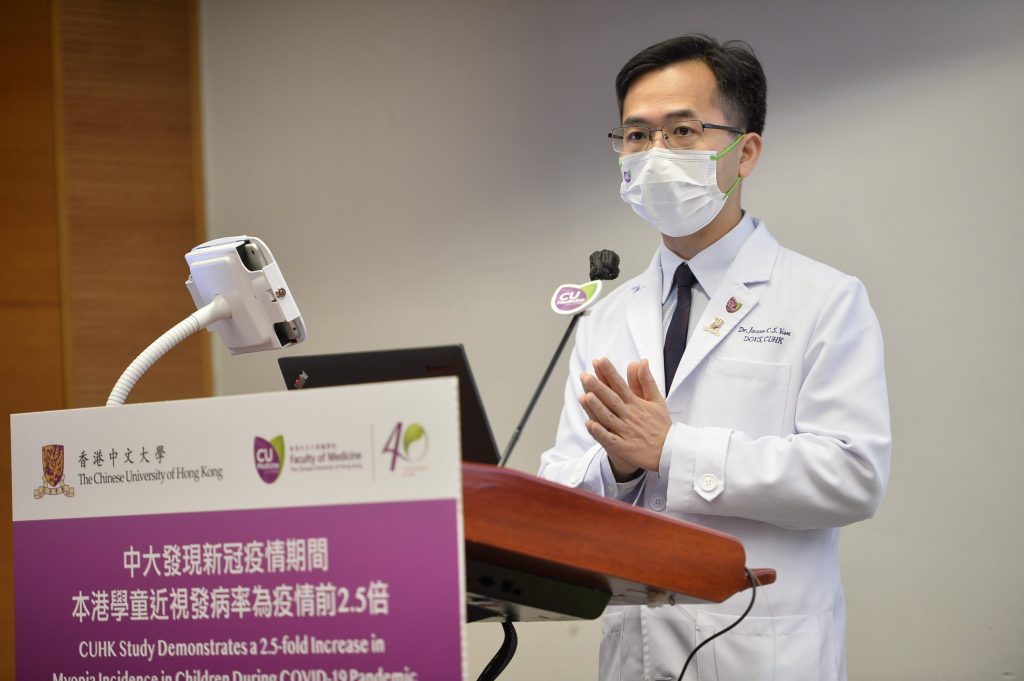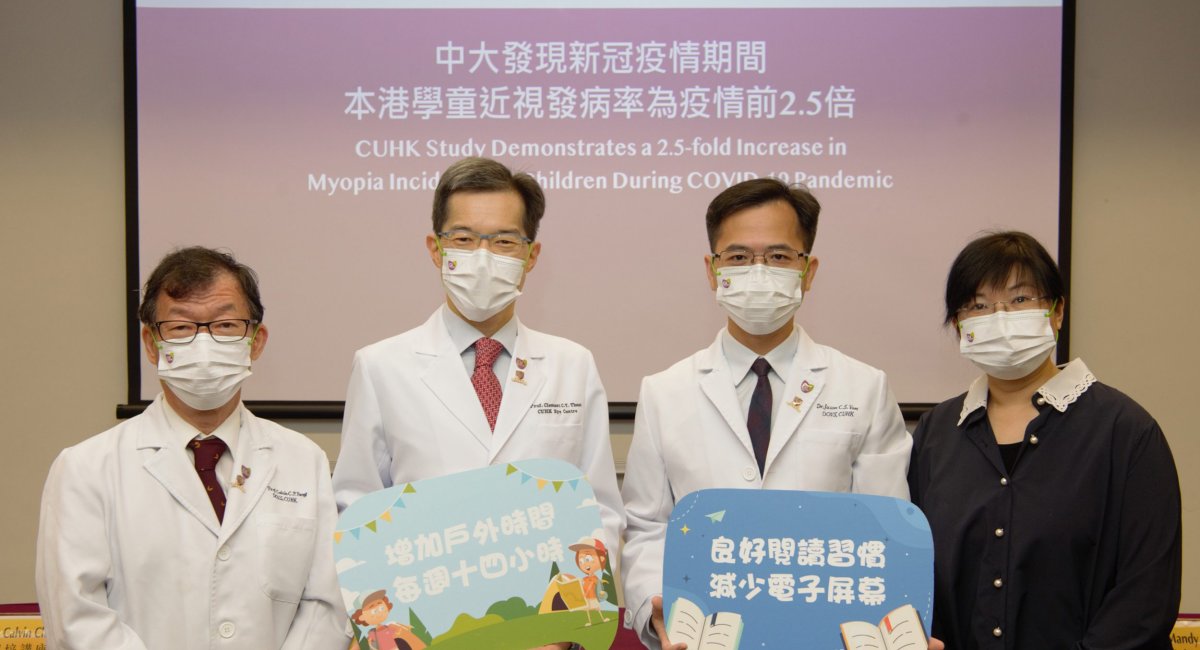
COVID-19 is causing profound disruptions in global health and economy, even affecting the lives of school children. In September 2020, closures of educational institutions were in effect in more than 180 countries, affecting 80% of the global student population. Similarly, the HKSAR government ordered complete or partial school closure during January 2020, affecting more than 800,000 students citywide. This unprecedented level of quarantine has prohibited outdoor activities and restricted daily routines to indoor activities. The impact of the COVID-19 pandemic on myopia incidence and progression among school children remain unknown.
In response, the Faculty of Medicine of The Chinese University of Hong Kong (CUHK) conducted a prospective population-based study to evaluate the impact of the COVID-19 pandemic on myopia incidence and progression among school-aged children in Hong Kong. These findings have been published in the international journal British Journal of Ophthalmology. The team hopes that their findings can be a warning to eye care professionals, educators and parents, that collective efforts are required to prevent childhood myopia, a potential public health crisis as a result of COVID-19.
Hong Kong has the highest prevalence of myopia worldwide
Myopia is the most common ocular disease worldwide and is responsible for multiple ocular complications highly risky to irreversible vision loss later in life due to excessive eyeball growth in myopia. It is predicted that approximately half of the world′s population will be myopic by 2050, with the highest prevalence in East Asia. Before COVID-19, Hong Kong already has the most common and serious myopia in the world, affecting more than 40% of our school children.
Prof Clement CY THAM, Chairman and S. H. Ho Professor of Ophthalmology and Visual Sciences from the Department of Ophthalmology and Visual Sciences, Faculty of Medicine at CUHK remarked, ″The concern of a myopia boom in children during COVID-19 hits particularly close to home, as Hong Kong is one of the world′s most densely populated cities, with the overwhelming majority of the population living in urban areas, where outdoor spaces are hard to come by. Under these circumstances, schoolchildren are spending significantly less time outdoors and more time on near work. These two behaviors are associated with myopia development and progression.″
Prof Calvin CP PANG, S. H. Ho Research Professor of Visual Sciences, The Chinese University of Hong Kong and Director of the Shantou University / The Chinese University of Hong Kong Joint Shantou International Eye Center explained, ″High myopia (above -6.00 diopters) can lead to sight-threatening complications, including glaucoma, retinal detachment and cataract. Wearing glasses or having laser refractive surgery can help improve vision, but cannot resolve the eyeball elongation problem or the risk of complications, therefore prevention should be the priority.″
COVID-19 triggered myopia boom
The pre-COVID-19 cohort consists of 1084 children that had been followed up until the COVID-19 outbreak in Hong Kong in January 2020. The COVID-19 cohort consists of 709 children recruited when school closures and restrictions on social activities were in place due to COVID-19 for at least eight months until August. Findings demonstrated that the lifestyle changes due to quarantine measures has triggered a myopia ″boom″ in school children in Hong Kong with a 2.5-fold increase in myopia incidence during the pandemic. Faster progression of myopia during COVID-19 compared to pre-COVID-19 is associated with significant reduction in outdoor time and increase in near work.
A breakdown of myopia incidence rate and progression rate in terms of SE progression and AL elongation as well as the lifestyle changes are summarized below:
| Myopia Progression | Pre-COVID-19 | COVID-19 |
| Myopia incidence (%) | 12 | 30 (estimated) |
| Annual SE progression (D) | -0.41 | -0.9 (estimated) |
| Annual AL elongation (mm) | 0.28 | 0.45 (estimated) |
| Lifestyle Changes | Pre-COVID-19 | COVID-19 |
| Outdoor time (minute/day) | 75 | 24 |
| Nearwork time (hour/day) | 3.5 | 8 |
Dr Jason CS YAM, Associate Professor from the Department of Ophthalmology and Visual Sciences, Faculty of Medicine at CUHK, Director of the CUHK Jockey Club Children Eye Care Programme, and Principal Investigator of this landmark study funded by Hong Kong Jockey Club Charities Trust, remarked, ″First, school children are recommended to increase outdoor time, 2 hours per day / 14 hours per week. On the premise of adequate social distancing, outdoor time should be incorporated into the daily schedule for school children to encourage a holistic lifestyle even during the pandemic. Second, the increasing reliance on digital devices needs to be addressed. As more educational activities are online, electronic devices are used more frequently for reading and writing, consequently much more near work for children. Educators and parents need to help children develop healthy usage of digital devices. Thirdly, considering such lifestyle shifts that affect vision, effective myopia control through pharmacological or optical interventions should be implemented to inhibit myopia progression in children at high-risk″
COVID-19 正在對全球健康和經濟造成嚴重破壞,甚至影響學童的生活。2020年9月,180多個國家的教育機構關閉,全球80%的學生群體受到影響。同樣,香港特區政府在 2020年1月,下令暫時關閉或部分關閉學校,全市超過800,000名學生受到影響。前所未有的檢疫隔離條例,使戶外活動受到限制,日常活動多局限于室內。COVID-19 大流行對香港學齡兒童近視發病率和進展的影響仍然未知。
對此,中大醫學院進行了一項基於人群調查的前瞻性研究,以評估COVID-19 大流行對香港學齡兒童近視發病率和進展的影響。這些發現已發表在國際期刊《英國眼科雜誌》上。其團隊希望他們的發現可以提醒眼保健專業人員、教育工作者和父母,COVID-19導致學童近視爆發增長這一潛在的公共衛生危機,需全體共同努力才可有效預防。
香港近視患病率全球最高
近視是世界範圍內最常見的眼部疾病,近視眼的眼球過度生長可導致眼部多種並發症,一些並發症有引起不可逆轉的視力喪失的風險。據預測,到2050年,全球近一半人口將出現近視,其中東亞人口的患病率最高。在COVID-19之前,香港已是世界上近視患病率最高的地區之一,40%以上的學童患有近視。
中大醫學院眼科及視覺科學學系主席兼何善衡眼科及視覺科學講座教授譚智勇教授表示:「在COVID-19期間,兒童近視的爆發增長尤其令人擔憂。香港是世界上人口最稠密的城市之一,絕大多數人居住在難以獲得足夠戶外空間的市區,這種情況下,學童在戶外的時間大大減少,而更多的時間用於近距離工作。這兩種行為與近視的發展和進展極爲相關。」
中大醫學院眼科及視覺科學學系何善衡眼科及視覺科學講座教授兼汕頭大學/香港中文大學聯合汕頭國際眼科中心院長彭智培教授解釋說:「高度近視(超過-6.00屈光度)會導致一些威脅視力的並發症,包括青光眼、視網膜脫離和白內障。戴眼鏡或進行激光屈光手術可以幫助改善視力,但不能解決眼球伸長的問題以及發生併發症的風險,因此應以預防爲主。」
COVID-19引發了近視暴增(myopia boom)
前COVID-19隊列共1084名兒童,他們在 2020年1月香港爆發COVID-19 之前完成了隨訪。COVID-19隊列是在COVID-19爆發時學校關閉和社交活動受限期間,招募了709名兒童並隨訪八個月。調查結果顯示,隔離措施導致的生活方式改變引發了香港學童出現近視情況急劇上升,大流行期間近視發病率增加了 2.5 倍。 與 COVID-19 之前相比,COVID-19 期間近視進展更快,這與戶外時間的顯著減少和近距離工作的增加有關。
近視發病率,每年屈光度進展和每年眼軸延長以及生活方式改變方面的細分總結如下:
| 近視進展 | Pre-COVID-19 | COVID-19 |
| 發病率(%) | 12 | 30 (估算) |
| 每年屈光度進展 (D) | -0.41 | -0.9 (估算) |
| 每年眼軸延長 (mm) | 0.28 | 0.45 (估算) |
| 生活方式改變 | Pre-COVID-19 | COVID-19 |
| 每天戶外活動時間 (分鐘) | 75 | 24 |
| 每天室內近距離工作時間(小時) | 3.5 | 8 |
中大醫學院眼科及視覺科學學系副教授、「香港中文大學賽馬會瞳心護眼計劃」總監暨本項由香港賽馬會慈善信託基金資助的研究的首席研究員任卓昇醫生表示:「首先,建議學童增加戶外時間,每天2小時或每週14小時。在保持足夠社交距離的前提下,即使在大流行期間,也應將增加戶外時間納入學童的日常安排,應鼓勵其健康的生活方式。其次,需要解決目前對電子設備日益依賴的問題。隨著越來越多的教育活動在線進行,電子設備被更頻繁地用於閱讀和寫作,導致孩子們近距離工作也越來越多。教育工作者和家長需要幫助孩子養成健康使用電子設備的習慣。第三,考慮到這種影響視力健康的生活方式轉變,應通過藥物或光學干預措施有效控制近視,預防兒童近視進展的風險。」
Reference:
- Zhang X, Cheung SSL, Chan HN, Zhang Y, Wang YM, Yip BH, Kam KW, Yu M, Cheng CY, Young AL, Kwan MYW, Ip P, Chong KK, Tham CC, Chen LJ, Pang CP, Yam JCS. Myopia incidence and lifestyle changes among school children during the COVID-19 pandemic: a population-based prospective study. British Journal of Ophthalmology Published Online First: 02 August 2021. doi: 1136/bjophthalmol-2021-319307
- https://twitter.com/CUHKMedicine/status/1432297366225256456?s=20

